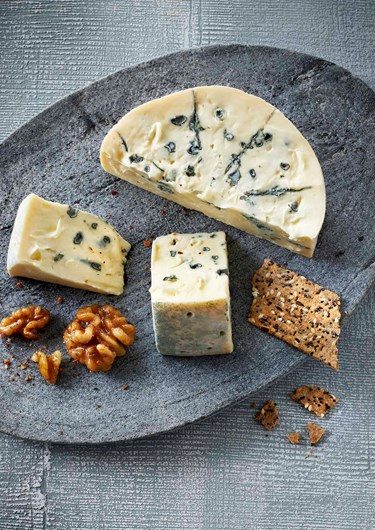
Creamy Blue
What is Creamy Blue?
Inspired by the mild and delicate nature of white mould cheeses and the intense profile of a traditional blue cheese, the Creamy Blue has become a classic of its own. Kickstarting your palate, it opens gently, slowly intensifying as it sits on your tongue. Braced with tones of toasted hops, the flavours are mild, bordering on tangy, with a creamy consistency to garnish and complete the profile. Its ivory-coloured body, imbued with blue veins that stretch like gushing rivers, is certain to sit perfectly at any table and beside any dish.
First introduced in 1969, the traditional ways of making the Creamy Blue are still maintained today, ensuring the same level of quality. A harmonic blend of light aromas and mild flavours make this cheese a nuanced and intricate experience worthy of sharing or enjoying on your own. Having a milder profile than a Danablu, it is the perfect choice for audiences that are unversed in blue mould cheeses.
Pair your Creamy Blue with toasted rye bread, fresh pears and roasted nuts, or let it accompany seared game or sit atop baked potatoes. Serve at room temperature by removing the cheese from the refrigerator at least half an hour before serving.
How Creamy Blue is made
From a nation of agriculture, Danish dairy farmers hold a strong catalogue of knowledge and experience that strongly echo in their cheese.
In mid-Jutland, Danish Jersey and red-pied cows provide fresh milk to the Gjesing dairy. The pasteurised milk is poured into traditional open vats, with added enzymes and a special blend of cultures encouraging the development of blue mould. Once the milk has curdled with the help of rennet, it is cut and milled to release excess whey, allowing for a smoother consistency. Placed in moulds, the curd is drained once more, before finally receiving a coating of salt to shield it from unwanted mould. Workers then pierce the rind with steel needles, allowing the mould to develop and breathe from the centre of the cheese. After the aging process, the cheese has fostered its marbling and achieved its soft and pliable texture.

Explore Castello Creamy Blue
Find your favourite Castello Creamy Blue now
Curious about the world of cheese? Here's everything you need to know about how to store, serve and cut cheese!

Discover our cheeses
A world of surprising and indulgent sensations




